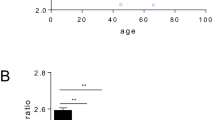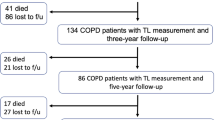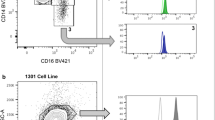Abstract
Introduction
Cellular senescence and fibrosis are important phenomena in the development of heart failure (HF). These processes are closely related to telomeric length (TL).
Aim
To assess cellular senescence in HF through the study of TL in peripheral blood mononuclear cells (PBMCs).
Methods
Using real-time PCR, TL was measured in PBMCs from 20 patients diagnosed with HF, aged between 51 and 77 years (50% males). Ten patients had HF with reduced ejection fraction (HFrEF) and ten had preserved EF (HFpEF). TL was measured in 20 healthy controls matched by age and gender. Obtained values were compared with an internal control, the 36B4 gene, which never modifies its expression, and correlated with the clinical parameters.
Results
TL mean was 1327 in patients with HF (95% CI 1309–1344) compared to 1286 (95% CI 1264–1308) in controls (p = 0.005). No differences were found when studying the correlation of telomere size with subgroups by gender, left ventricle ejection fraction (LVEF), presence of ischemic heart disease, smoking, Chronic Obstructive Pulmonary Disease (COPD), NYHA stage, degree of renal function or number of hospital admissions in the previous year. A significant and negative correlation was found between age and renal function (r = – 0.544, p < 0.05), as well as LVEF and NT-proBNP values (ρ = – 0.475, p < 0.05).
Conclusions
TL is shorter in patients with HF when compared with age and gender balanced controls. The shortening of TL is independent of age, gender and degree of kidney function, and does not correlate with LVEF decrease or functional status.

Similar content being viewed by others
Change history
11 May 2021
A Correction to this paper has been published: https://doi.org/10.1007/s40292-021-00459-5
References
Ponikowski P, Voors AA, Anker SD, et al. ESC Guidelines for the diagnosis and treatment of acute and chronic heart failure: the Task Force for the diagnosis and treatment of acute and chronic heart failure of the European Society of Cardiology (ESC). Developed with the special contribution of the Heart Failure Association (HFA) of the ESC. Eur J Heart Fail. 2016;18(8):891–975.
Dávila DF, Núñez TJ, Odreman R, et al. Mechanisms of neurohormonal activation in chronic congestive heart failure: pathophysiology and therapeutic implications. Int J Cardiol. 2005;101(3):343–6.
Martínez P, Blasco MA. Replicating through telomeres: a means to an end. Trends Biochem Sci. 2015;40(9):504–15.
Calado RT, Young NS. Telomere diseases. N Engl J Med. 2009;361(24):2353–65.
Serra V, Grune T, Sitte N, et al. Telomere length as a marker of oxidative stress in primary human fibroblast cultures. Ann NY Acad Sci. 2000;908:327–30.
Huzen J, Wong LS, Van Veldhuisen DJ, et al. Telomere length loss due to smoking and metabolic traits. J Intern Med. 2014;275(2):155–63.
Graakjaer J, Pascoe L, Der-Sarkissian H, et al. The relative lengths of individual telomeres are defined in the zygote and strictly maintained during life. Aging Cell. 2004;3(3):97–102.
Wong JMY, Collins K. Telomere maintenance and disease. Lancet. 2003;362(9388):983–8.
Folini M, Gandellini P, Zaffaroni N. Targeting the telosome: therapeutic implications. Biochem Byophys Acta. 2009;1792(4):309–16.
Armanios M, Blackburn EH. The telomere syndromes. Nat Rev Genet. 2012;13(10):693–704.
Kirchner H, Shaheen F, Kalscheuer H, et al. The telomeric complex and metabolic disease. Genes. 2017;8(7):176.
Ma L, Li Y, Wang J. Telomeres and essential hypertension. Clin Biochem. 2015;48(16–17):1195–9.
Daniali L, Benetos A, Susser E, et al. Telomeres shorten at equivalent rates in somatic tissues of adults. Nat Commun. 2013;4:1597.
Dlouha D, Maluskova J, Kralova Lesna I, et al. Comparison of the relative telomere length measured in leukocytes and eleven different human tissues. Physiol Res. 2014;63(Suppl 3):343-50.
Olivieri F, Antonicelli R, Recchioni R, et al. Telomere / telomerase system impairment in circulating angiogenic cells of geriatric patients with heart failure. Int J Cardiol. 2013;164(1):99–105.
van der Harst P, van der Steege G, Boer RA, et al. Telomere length of circulating leukocytes is decreased in patients with chronic heart failure. J Am Coll Cardiol. 2007;49(13):1459–64.
van der Harst P, Boer RA, Samani NJ, et al. Telomere length and outcome in heart failure. Ann Med. 2010;42(1):36–44.
Wong LS, van der Harst P, Boer RA, et al. Renal dysfunction is associated with shorter telomere length in heart failure. Clin Res Cardiol. 2009;98(10):629–34.
Haver VG, Matthew Leach I, Kjekshus J, et al. Telomere length and outcomes in ischaemic heart failure: data from the Controlled ROsuvastatin multiNAtional Trial in Heart Failure (CORONA). Eur J Heart Fail. 2015;17(3):313–9.
Sharifi-Sanjani M, Oyster NM, Tichy ED, et al. Cardiomyocyte-specific telomere shortening is a distinct signature of heart failure in humans. J Am Heart Assoc. 2017;6(9):e005086.
O’Donnell CJ, Demissie S, Kimura M, et al. Leukocyte telomere length and carotid artery intimal medial thickness: the Framingham Heart Study. Arterioscler Thromb Vasc Biol. 2008;28(6):1165–71.
Fitzpatrick AL, Kronmal RA, Gardner JP, et al. Leukocyte telomere and cardiovascular disease in the Cardiovascular Health Study. Am J Epidemiol. 2007;165(1):14–21.
Brouilette SW, Moore JS, McMahon AD, et al. Telomere length, risk of coronary heart disease, and statin treatment in the West of Scotland Primary Prevention Study: a nested case-control study. Lancet. 2007;369(9556):107–14.
D’Mello MJJ, Ross SA, Anand SS, et al. Telomere length and risk of myocardial infarction in a multiethnic population: the INTERHEART Study. J Am Coll Cardiol. 2016;67(15):1863–5.
Østhus IBØ, Lydersen S, Dalen H, et al. Association of telomere length with myocardial infarction: a prospective cohort From the Population Based HUNT 2 Study. Prog Cardiovasc Dis. 2017;59(6):649–55.
Jessup M, Brozena S. Medical progress: heart failure. N Engl J Med. 2003;348:2007–18.
Author information
Authors and Affiliations
Corresponding author
Ethics declarations
Funding
The present research project has been carried out with funds from the University of Zaragoza (Spain).
Conflict of interest
The present authors of the manuscript declare the absence of conflict of interest.
Rights and permissions
About this article
Cite this article
Elena, B., María Izarbe, MC., Susana, OG. et al. Study of Cellular Aging in a Cohort of Patients with Heart Failure. High Blood Press Cardiovasc Prev 28, 49–55 (2021). https://doi.org/10.1007/s40292-020-00421-x
Received:
Accepted:
Published:
Issue Date:
DOI: https://doi.org/10.1007/s40292-020-00421-x




